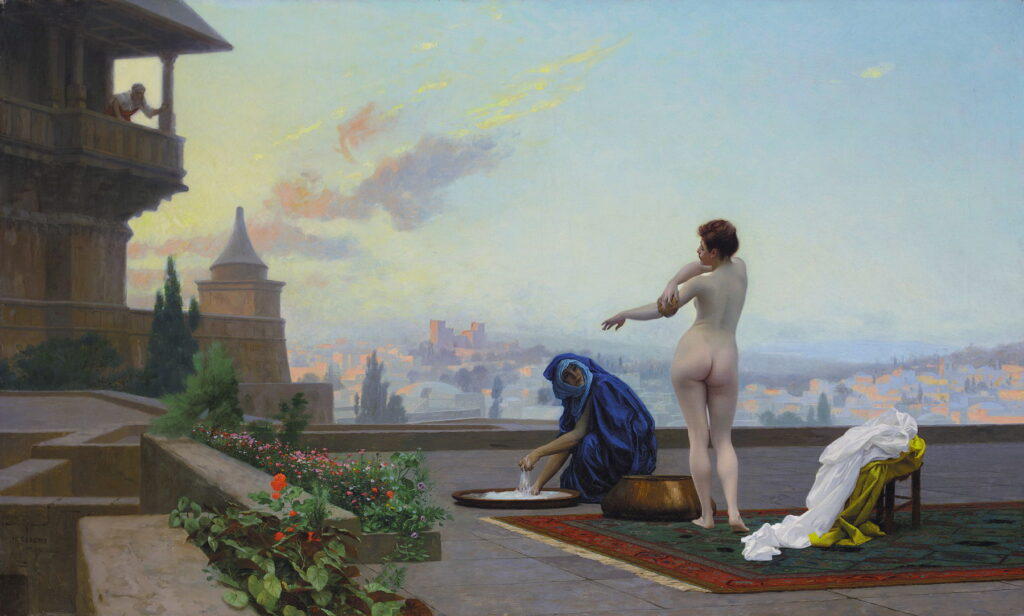Paintings of Bathsheba and King David: voyeurism rewarded 2

By 1650, most of the paintings telling the Old Testament story of Bathsheba and King David had shown its opening scene, featuring the nude figure of Bathsheba in the foreground, and a distant king watching her from his balcony. Visual clues as to the rest of the story were unusual, and most paintings were hard to read as anything more than an excuse to expose female flesh in an ostensibly religious context. It was Rembrandt who changed that, in his late account.
Rembrandt Harmenszoon van Rijn (1606-1669), Bathsheba with King David’s Letter (1654), oil on canvas, 142 x 142 cm, Musée du Louvre, Paris. Wikimedia Commons.
Here, in his Bathsheba with King David’s Letter (1654), Rembrandt has moved on from the opening scene to an imagined moment later in time. Bathsheba is again at her bath, this time in the privacy of her bedchamber, her feet being cared for by an old and presumably worldly-wise maid or nurse.
Clutched in Bathsheba’s right hand is a letter, the title tells us from the king himself. Her eyebrows are raised in surprise, and she stares dreamily down at her attendant. We must presume that this letter is the king’s invitation to her to join with him in adultery. Rembrandt skilfully heightens the suspense in the lighting, and enhances the intimate detail with Bathsheba’s jewellery and ornamented hair. The crumpled sheets behind her make it clear that David’s invitation isn’t to a public engagement, but to a very private one.
Rembrandt Harmenszoon van Rijn (1606-1669), Bathsheba with King David’s Letter (detail) (1654), oil on canvas, 142 x 142 cm, Musée du Louvre, Paris. Wikimedia Commons.
Bathsheba’s expression and poise tell much of the story: she has a look of the inevitable, with more than a tinge of regret. She must already have been wondering how this would work out with her husband, whose fate clearly rested with the king too. Rembrandt’s model for this masterpiece was his mistress, Hendrickje Stoffels, who had previously been his maid. After his wife died in 1642, just before his earlier painting of Bathsheba, Stoffels and Rembrandt lived together as a couple.
After about 1665, Rembrandt also painted Uriah, Bathsheba’s husband, leaving King David with the instruction that would take him to his death, in David and Uriah, formerly known as Haman Recognises his Fate, which doesn’t feature Bathsheba.
Cornelis Bisschop (1630–1674), Bathsheba (c 1663), oil on panel, 39.4 × 33.7 cm, Norton Simon Museum, Pasadena, CA. Wikimedia Commons.
Just a decade later, Cornelis Bisschop tried mixing the two scenes in his Bathsheba (c 1663). She sits with her feet soaking in a pond, with the king watching her from a balcony at the top right. Bathsheba is also reading a letter, presumably an invitation from the voyeur king in the distance. In front of her are apples hanging on a tree, in a reference to Eve in the garden of Eden, although the story of the fall of man is the converse of that of the fall of Bathsheba.
Adriaen van der Werff (1659–1722), Bathsheba (1714), oil on panel, 45 x 33 cm, location not known. Wikimedia Commons.
In 1714, Adriaen van der Werff painted a traditional version of Bathsheba, who is combing her hair under the distant gaze of King David, in a composition similar to that of Rembrandt’s first version from 1643.
Nikolaas Verkolje (1673–1746), David Spying on Bathsheba (1716), oil on copper, 62.5 x 52 cm, Private collection. Wikimedia Commons.
Nikolaas Verkolje’s David Spying on Bathsheba from 1716 remains with the conventional approach, with a nude Bathsheba looking in a mirror in the foreground, as King David watches on from his balcony, in the upper left corner.
Jean François de Troy (1679–1752), Bathsheba at her Bath (1750), oil on canvas, 101 x 135.8 cm, Philbrook Museum of Art, Tulsa, OK. Wikimedia Commons.
So says Jean François de Troy in his painting of Bathsheba at her Bath from 1750.
François Boucher (1703–1770), David and Bathsheba (c 1750), oil on canvas, 152 x 116 cm, Museu Nacional de Arte Antiga, Lisbon, Portugal. Wikimedia Commons.
Also François Boucher in his David and Bathsheba from the same time.
William Blake (1757–1827), Bathsheba at the Bath (1799–1800), tempera on canvas, 26.3 x 37.6 cm, The Tate Gallery (Presented by the Art Fund 1914), London. © The Tate Gallery and Photographic Rights © Tate (2016), CC-BY-NC-ND 3.0 (Unported), http://www.tate.org.uk/art/artworks/blake-bathsheba-at-the-bath-n03007
Then in about 1800, William Blake included Bathsheba at the Bath in a series of paintings of biblical narratives. Although he transplants the figures into a more pastoral setting, he too keeps to the tradition of the nearby nearly nude Bathsheba, and the distant elevated king at the right.
David Wilkie (1785-1841), Bathsheba (1815), oil on panel, 38.3 x 30.4 cm, California Palace of the Legion of Honor, Fine Arts Museums of San Francisco, San Francisco, CA. The Athenaeum.
I don’t know if the Scottish artist David Wilkie had seen Blake’s work, but his Bathsheba from 1815 is also set in the countryside. Bathsheba is now beside a small stream where she has been bathing, and is just donning a stocking. King David is shown as much a voyeur as the two elders were of Susanna.
Francesco Hayez (1791–1881), Bathsheba at her Bath (1845), oil on panel, 107 x 77 cm, Pinacoteca di Brera, Milan, Italy. Wikimedia Commons.
Francesco Hayez elaborates the same theme in his Bathsheba at her Bath from 1845: she is being dressed by her attendants, and the voyeur king leers over a wall in the distance, almost lost amid the trees, looking quite sinister.
Jean-Léon Gérôme (1824–1904), Bathsheba (1889), oil on canvas, 60.5 x 100 cm, Private collection. Wikimedia Commons.
As you might expect, Jean-Léon Gérôme’s Bathsheba (1889) is a literal interpretation of the story. Watching Bathsheba washing in her small roof-garden is the figure of David, leaning forward to get as close a look as he can. At this late stage in his career, Gérôme had painted several Orientalist views among rooftops, and this seems to have developed from those.
Paul Cézanne (1839-1906), Bathsheba (c 1885-1890), oil on canvas, 32.1 x 23.5 cm, Private collection. The Athenaeum.
Paul Cézanne painted at least two different versions of Bathsheba, including this from about 1885-90. Interestingly they are not from his early period of narrative works, but quite late in his career, and perhaps fit better with his succession of paintings of bathers. Neither version shows King David, so without knowing their theme could be a challenge to read. The forms of Bathsheba and her maid are echoed in the heaped up cumulus clouds.
Lovis Corinth (1858-1925), Bathsheba (1908), oil on canvas, 156 x 175 cm, Galerie Neue Meister, Dresden, Germany. The Athenaeum.
Lovis Corinth had become interested in, and painted, Susanna and the elders early in his career, but appears not to have been so enthused over this story. His Bathsheba from 1908 is a curious treatment: Bathsheba herself is not the most attractive of the nudes painted by Corinth, and lies back on her bed holding a red rose in her right hand, looking dreamily at the viewer. Beside her is a maid whose form is much looser, but there is no sign of David.
Franz von Stuck (1863–1928), Bathsheba (1912), oil on canvas, 95 × 91 cm, Museo Nacional de Bellas Artes, Buenos Aires, Argentina. Wikimedia Commons.
My final painting comes from Franz von Stuck, his Bathsheba of 1912. Von Stuck had a career-long fascination with the femme fatale that seems to have brought him to a different position over Bathsheba and her relationship with the king. King David the voyeur is shown in silhouette on his palace roof, holding a daemonic trident, but Bathsheba looks and smiles at us knowingly as she emerges from her luxuriant pool: she performed for the spectator behind her.
Although I think von Stuck has travelled too far from the Biblical narrative, his painting raises some interesting questions in comparison with the story of Susanna and the elders. In that case, there was no doubt that Susanna was bathing in the seclusion of her own garden, and that the elders invaded her privacy, watched her, and tried to blackmail her into having sex with them. The story of Bathsheba doesn’t provide detail over the privacy of Bathsheba’s bath. In contrast to Susanna’s secluded bathing, Bathsheba is universally shown as bathing where her body is exposed to David’s view, with the implication that she could have done so knowing that the king would be able to see her.
The trouble with this approach is that it only confuses the fact that David asked her to commit adultery, or possibly raped her. Although he is eventually punished for his sins, as they consisted of the breach of two commandments, adultery and murder, in Bathsheba’s story virtue is abandoned, and it is privileged male power that triumphs.




